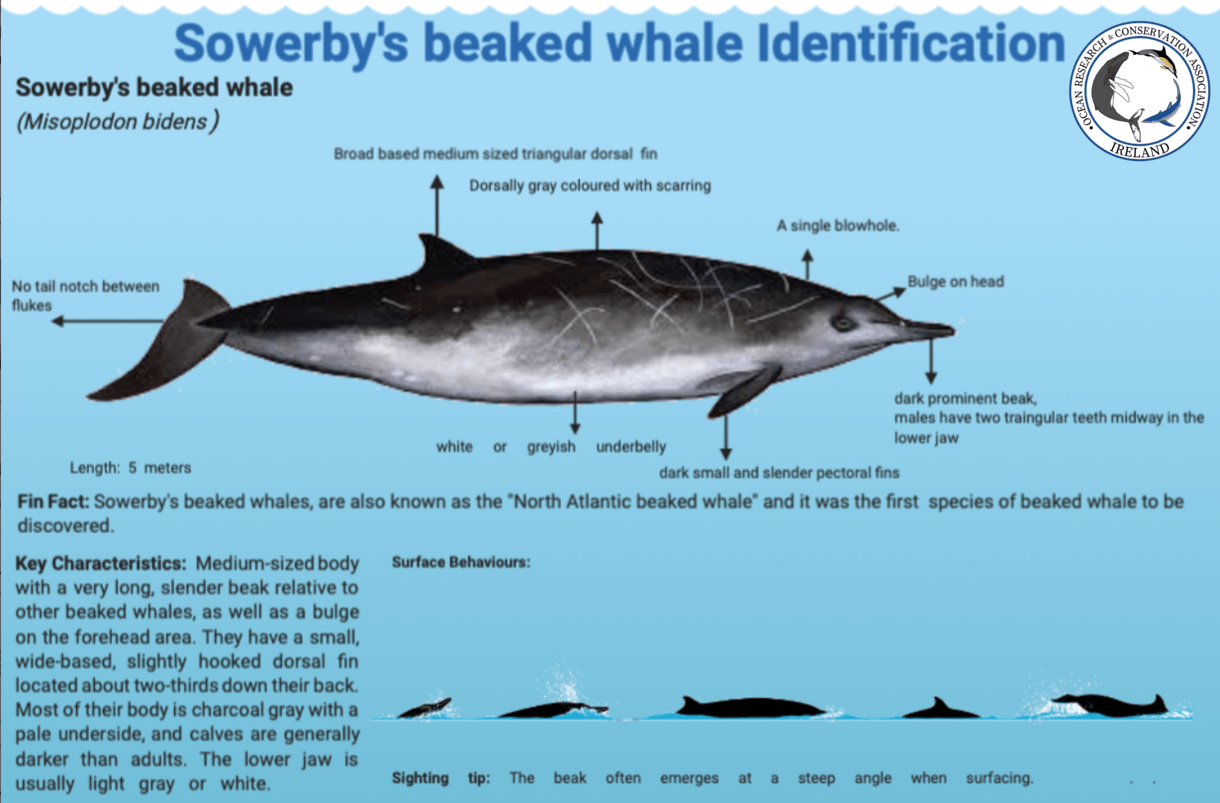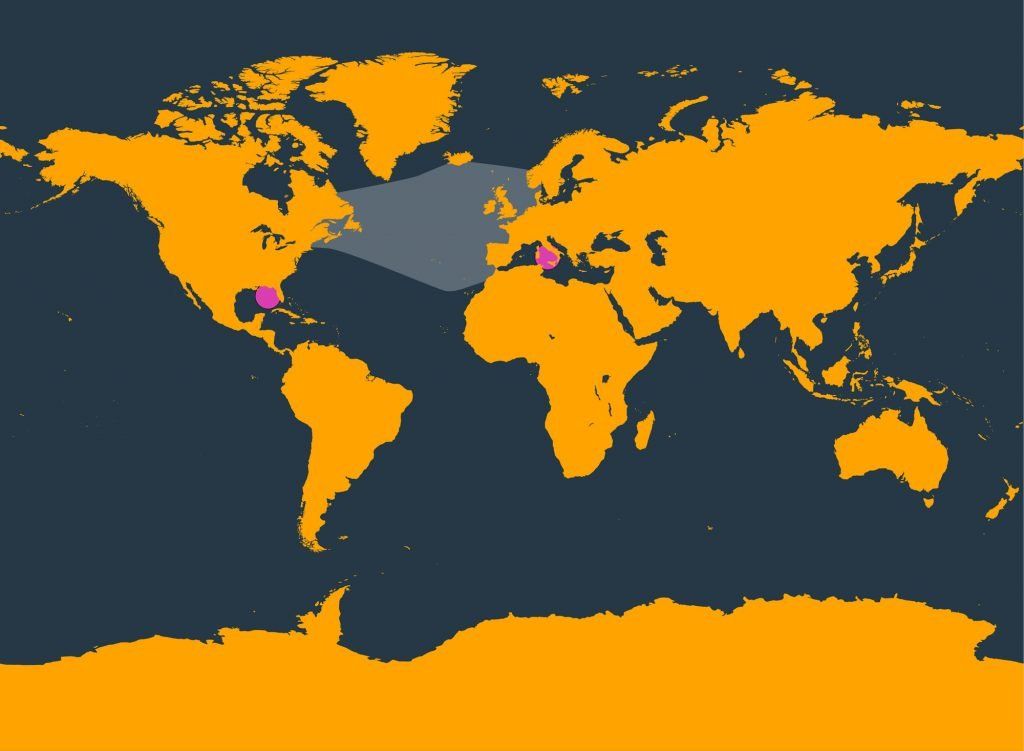Sowerby's Beaked Whale
(Mesoplodon bidens)
Sowerby's beaked whale. Photo credit: NOAA/NEFSC Desray Reeb (BOEM).
Next Species -->
<---Previous species
Classification:
Kingdom:
Animalia
Phylum:
Chordata
Class: Mammalia
Order: Artiodactyla
Infraorder:
Cetacea
Family:
Ziphiidae
Genus:
Mesoplodon
Species:
M. bidens
Get the Facts:
Sowerby's beaked whales (Mesoplodon bidens), also known as the "North Atlantic beaked whale," are little known members of the beaked whale family, Ziphiidae. Sowerby's beaked whales were the first beaked whale to be discovered. Their scientific name, bidens, is derived from the Latin words bi for "two" and dens for "teeth" and refers to the pair of visible teeth that erupt from the lower jaw of mature males.
Species Identification:
Sowerby's beaked whales have a medium-sized body with a very long, slender beak relative to other beaked whales, as well as a bulge on the forehead area. The beak often emerges at a steep angle when surfacing. They have a small, wide-based, slightly hooked dorsal fin located about two-thirds down their back. Most of their body is charcoal gray with a pale underside, and calves are generally darker than adults. The lower jaw is usually light gray or white. This species has less visible scarring than most other beaked whale species. Males, which are generally larger, can be distinguished from females and juveniles by a pair of visible teeth that erupt from their slightly arched lower jaw. Females and juveniles also have teeth, but they remain hidden beneath the gum tissue, and their jawline is straight.
Many species of beaked whales (especially those in the genus Mesoplodon) are very difficult to distinguish from one another (even when dead) because they lack easily discernible or apparent physical characteristics. At sea, they are challenging to observe and identify to the species level because of their cryptic, skittish behaviour; low profile; and a small, inconspicuous blow at the water’s surface. Therefore, much of the available characterisation for beaked whales is to the genus level only, and there is relatively little information about most individual species.
Diet:
Sowerby's beaked whales use suction to feed on small, deep-sea fish and cephalopods (e.g., squid) in deep waters.
Habitat:
Sowerby's beaked whales are an offshore species that are rarely encountered in coastal areas, however there have been records of this species coming close to shore to die. On July 4th 2020, a distressed Sowerby's beaked whale was reported to the Observers App in Wicklow Harbour and later passed away. Generally Sowerby's beaked whales are found in deep offshore waters off the continental shelf slope, where their preferred prey, squid and octopus are found. The spatial and temporal occurrence of beaked whales was examined using static acoustic monitoring on the western shelf edge in 2015-20016 under the Observer/Acoustics Project and results suggested that there is a spatial segregation between the two species. Cuvier’s clicks were more abundant at lower latitudes while Sowerby’s were greater at higher latitudes, particularly in the spring, suggesting a spatial segregation between species, possibly driven by prey preference (Kowarski et al., 2018).
Behaviour:
Regular dives range from 10 to 15 minutes, but dives of at least 28 minutes and reaching depths up to 1,500 meters have been recorded. When surfacing, this species often lifts its head up out of the water at a 45-degree angle.
Social Structure:
Sowerby's beaked whales are usually found individually or in small, closely associated groups averaging between three and ten individuals.
Reproduction:
Sowerby's beaked whales may reach sexual maturity at about age 7, and their breeding season may be from late winter to spring. A sexually mature female will give birth to a single newborn calf that is about 5 metres long and weighs about 170 kilograms.
Lifespan:
The estimated lifespan of this species is unknown.
Global Distribution:
With one of the most northerly distributions of all the beaked whales, Sowerby's beaked whales and are found predominantly in the eastern North Atlantic. Sowerby's beaked whales prefer the deep, cold temperate and subarctic waters off the continental shelf edge of the North Atlantic Ocean but have also been reported near the ice pack. They are distributed throughout the North Atlantic Ocean (30° to 71° North), ranging from the Norwegian Sea, Labrador Sea, Iceland, and Baltic Sea to the north, and waters off the northeast United States, Madeira, and the Canaries to the south. Sowerby’s beaked whales may be more common in the eastern than the western North Atlantic Ocean. However, they rarely occur in the Mediterranean Sea. Strandings have occurred in Florida and Italy, but these areas are considered outside their normal range. Their distribution may vary depending on the movements of oceanographic currents. It is unknown whether they undertake seasonal movements or migrations.
Population Status:
There is little information on the abundance of this species worldwide. Thus, data are insufficient to estimate population trends.
Conservation Threats:
Sowerby’s beaked whales have become entangled or captured in commercial fishing gear, such as driftnets and gillnets. Deep-diving cetaceans like Sowerby's beaked whales rely on sound to feed, communicate, and navigate in the ocean. Sound pollution threatens them by interrupting their normal behavior and driving them away from areas important to their survival.






